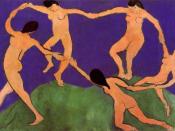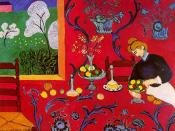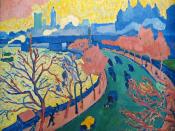Phoebe Prowse
Art Case Study: Fauvism Movement
Section 1- Conceptual Framework
Artist:
Fauvism, (French for 'wild beats') was an extremely influential movement to 20th century art, extending from 1904-1908. It was characterized by paintings, usually of distorted landscapes which used extremely bright, vivid, lively colours and wild brush strokes. The movement was inspired by impressionism and post impressionism, but with even more saturated and loud colour and disregard for actual forms than what these movements had. Three artists are Henri Matisse, Andre Derain and Maurice de Vlaminck. The three companions, along with others, formed the group of fauves, and held their first exhibition together in 1905.
Henri Matisse:
Form: painting
Description: In Henri Matisse's "Dance (I)" five womanly figures are depicted holding hands to form a circle, and dancing. The painting is fairly simple and abstract. Only the outlines of the women's basic features are shown using black, thin lines- the buttocks, breasts, hair, arms, legs etc in a naïve, elementary fashion.
A technique called 'contrapposto' has been used, which is used to depict the freedom of movement which the figures have. Only 3 basic colours have been used- greens of similar shades for the grassy patch in the lower third of the painting, deep, bright and vibrant cool blue for the background, and a skin colour, in mixtures of yellow and pink tones for the women. The shapes used are very organic and flow throughout the painting. The women arms and bodies are curved, being hardly any straight line. The line separating the grass from sky is very wavy. Two of the three women's faces shown have hints of simple facial features.
Interpretations/judgments: This painting I find is very simple and naive, with its basic colour palette, shapes, subject and clear use of...


